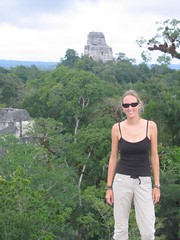Getting on with it...

EDIT: Here is a photo link to all my pictures. Pop Quiz: what TV show recently featured these ruins? And what movie featured a five-second scene shot here? For answers, view my photoset!
After two busy holiday weeks, and a quick ski trip up to Vermont, I'm back in CT and getting ready to seriously think about preparing to work on starting to look for a job. I'm starting out with some baby steps, and just like a baby, some of those first tentative steps wind up with me falling on my butt. For instance, my attempt to set up a wireless router in the house here resulted in four hours of frustrated phone calls to various Tech Support numbers and an eventual trip to the post office to return the (apparently faulty) router to Amazon. The new one should arrive today and the process will begin again, hopefully with more success now that I am a seasoned wireless-router-installater.
I've uploaded some more photos from my trip, this time from the Mayan ruins at Tikal in Guatemala. These were different from other ruins I saw in that these are still pretty much buried in the forest. We'd climb all the stairs (huff, puff) to the top of the temples and look out across the thick forest (home to countless loud howler monkeys) to see the tops of the other temples. The forest has grown in since the height of the Mayan civilization (around 250-900 AD); when the city was inhabited, the spaces between the structures was all open. It's hard to imagine a bustling community moving about their daily business where today there is only stillness, wildlife and tourists.
This time, I finally hired a guide and it was totally worth it. Juan showed us around for about six or seven hours, explaining the history of the ruins, the Maya culture and some of the fascinating and bewildering astronomical observations they made. They tracked the sun and the planets, and build their structures based on the position of the sun at the equinoxes. They had a yearly calendar of 18 20-day months plus five "unlucky" days at the end of the year. The number 260 was also important and was the basis of an early calendar; it was tied to the human 9-month gestation period and the cycle of Venus around the sun--I had never realized they are roughly the same. The 360-day and 260-day periods apparently cycle around and overlap every 52 years, an important period of time for building temples, having ceremonies, etc. The Maya were very into human sacrifice, which took place at all kinds of ceremonies, and also self-mutilation done by priests: drawing blood from the tongue or, er, the genitals, as an offering to the gods. It seems like a difficult place to live, when you think about the ceremonies and sacrifices. But we also saw some residential areas of the city (once home to about 120,000 people), and the Ball Court, home to a ball game whose rules are still a mystery to us, but which was, after all, a game. It's fascinating to try to imagine families and kids living, laughing and playing, in some ways totally different and yet at heart the same as you or me.












<< Home